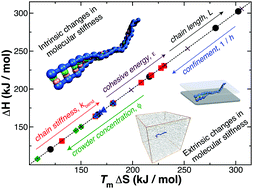当前位置:
X-MOL 学术
›
Soft Matter
›
论文详情
Our official English website, www.x-mol.net, welcomes your feedback! (Note: you will need to create a separate account there.)
Molecular rigidity and enthalpy–entropy compensation in DNA melting
Soft Matter ( IF 3.4 ) Pub Date : 2017-10-23 00:00:00 , DOI: 10.1039/c7sm01220a Fernando Vargas-Lara 1, 2, 3, 4 , Francis W. Starr 4, 5, 6, 7 , Jack F. Douglas 1, 2, 3, 4
Soft Matter ( IF 3.4 ) Pub Date : 2017-10-23 00:00:00 , DOI: 10.1039/c7sm01220a Fernando Vargas-Lara 1, 2, 3, 4 , Francis W. Starr 4, 5, 6, 7 , Jack F. Douglas 1, 2, 3, 4
Affiliation

|
Enthalpy–entropy compensation (EEC) is observed in diverse molecular binding processes of importance to living systems and manufacturing applications, but this widely occurring phenomenon is not sufficiently understood from a molecular physics standpoint. To gain insight into this fundamental problem, we focus on the melting of double-stranded DNA (dsDNA) since measurements exhibiting EEC are extensive for nucleic acid complexes and existing coarse-grained models of DNA allow us to explore the influence of changes in molecular parameters on the energetic parameters by using molecular dynamics simulations. Previous experimental and computational studies have indicated a correlation between EEC and changes in molecular rigidity in certain binding–unbinding processes, and, correspondingly, we estimate measures of DNA molecular rigidity under a wide range of conditions, along with resultant changes in the enthalpy and entropy of binding. In particular, we consider variations in dsDNA rigidity that arise from changes of intrinsic molecular rigidity such as varying the associative interaction strength between the DNA bases, the length of the DNA chains, and the bending stiffness of the individual DNA chains. We also consider extrinsic changes of molecular rigidity arising from the addition of polymer additives and geometrical confinement of DNA between parallel plates. All our computations confirm EEC and indicate that this phenomenon is indeed highly correlated with changes in molecular rigidity. However, two distinct patterns relating to how DNA rigidity influences the entropy of association emerge from our analysis. Increasing the intrinsic DNA rigidity increases the entropy of binding, but increases in molecular rigidity from external constraints decreases the entropy of binding. EEC arises in numerous synthetic and biological binding processes and we suggest that changes in molecular rigidity might provide a common origin of this ubiquitous phenomenon in the mutual binding and unbinding of complex molecules.
中文翻译:

DNA熔解中的分子刚性和焓-熵补偿
焓-熵补偿(EEC)在对生命系统和制造应用很重要的各种分子结合过程中均被观察到,但是从分子物理学的角度来看,这种广泛存在的现象还不够充分。为了深入了解这个基本问题,我们将重点放在双链DNA(dsDNA)的解链上,因为显示EEC的测量范围广泛,适用于核酸复合物,而现有的DNA粗粒度模型使我们能够探索分子参数变化的影响通过使用分子动力学模拟来分析高能参数。先前的实验和计算研究表明,在某些结合-解结合过程中,EEC与分子刚性变化之间存在相关性,因此,我们估算了在各种条件下DNA分子刚性的度量,以及结合焓和结合熵的最终变化。特别是,我们考虑了由固有分子刚性的变化引起的dsDNA刚性的变化,例如,DNA碱基之间的缔合相互作用强度,DNA链的长度以及单个DNA链的抗弯刚度发生了变化。我们还考虑了由于聚合物添加剂的添加和平行板之间DNA的几何限制而引起的分子刚性的外在变化。我们所有的计算都证实了EEC,并表明该现象确实与分子刚性的变化高度相关。但是,从我们的分析中发现了两个与DNA刚度如何影响缔合熵有关的不同模式。增加固有DNA刚度会增加结合的熵,但是由于外部约束而导致分子刚度的增加会降低结合的熵。EEC出现在许多合成和生物结合过程中,我们认为分子刚性的变化可能为复杂分子的相互结合和非结合中这种普遍存在的现象提供了共同的起源。
更新日期:2017-11-15
中文翻译:

DNA熔解中的分子刚性和焓-熵补偿
焓-熵补偿(EEC)在对生命系统和制造应用很重要的各种分子结合过程中均被观察到,但是从分子物理学的角度来看,这种广泛存在的现象还不够充分。为了深入了解这个基本问题,我们将重点放在双链DNA(dsDNA)的解链上,因为显示EEC的测量范围广泛,适用于核酸复合物,而现有的DNA粗粒度模型使我们能够探索分子参数变化的影响通过使用分子动力学模拟来分析高能参数。先前的实验和计算研究表明,在某些结合-解结合过程中,EEC与分子刚性变化之间存在相关性,因此,我们估算了在各种条件下DNA分子刚性的度量,以及结合焓和结合熵的最终变化。特别是,我们考虑了由固有分子刚性的变化引起的dsDNA刚性的变化,例如,DNA碱基之间的缔合相互作用强度,DNA链的长度以及单个DNA链的抗弯刚度发生了变化。我们还考虑了由于聚合物添加剂的添加和平行板之间DNA的几何限制而引起的分子刚性的外在变化。我们所有的计算都证实了EEC,并表明该现象确实与分子刚性的变化高度相关。但是,从我们的分析中发现了两个与DNA刚度如何影响缔合熵有关的不同模式。增加固有DNA刚度会增加结合的熵,但是由于外部约束而导致分子刚度的增加会降低结合的熵。EEC出现在许多合成和生物结合过程中,我们认为分子刚性的变化可能为复杂分子的相互结合和非结合中这种普遍存在的现象提供了共同的起源。



























 京公网安备 11010802027423号
京公网安备 11010802027423号